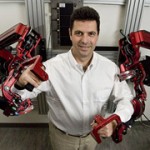Archive for Январь 20th, 2009
Neural network committees for finger joint angle estimation from surface EMG signals
- Тип контента: Научная статья
- Номер документа: 6241
- Название документа: Neural network committees for finger joint angle estimation from surface EMG signals
- Номер (DOI, IBSN, Патент): 10.1186/1475-925X-8-2
- Изобретатель/автор: Nikhil A Shrirao, Narender P Reddy, Durga R Kosuri
- Правопреемник/учебное заведение: University of Akron
- Дата публикации документа: 2009-01-20
- Страна опубликовавшая документ: США
- Язык документа: Английский
- Наименование изделия: Не заполнено
- Источник: BioMedical Engineering OnLine
- Вложения: Да
- Аналитик: Глаголева Елена
 Background: In virtual reality (VR) systems, the user’s finger and hand positions are sensed and used to control the virtual envi-ronments. Direct biocontrol of VR environments using surface electromyography (SEMG) signals may be more synergistic and uncons-training to the user. The purpose of the present investigation was to develop a technique to predict the finger joint angle from the surface EMG measurements of the extensor muscle using neural network models.
Background: In virtual reality (VR) systems, the user’s finger and hand positions are sensed and used to control the virtual envi-ronments. Direct biocontrol of VR environments using surface electromyography (SEMG) signals may be more synergistic and uncons-training to the user. The purpose of the present investigation was to develop a technique to predict the finger joint angle from the surface EMG measurements of the extensor muscle using neural network models.
Methodology: SEMG together with the actual joint angle measurements were obtained while the subject was performing flexion-exten-sion rotation of the index finger at three speeds. Several neural networks were trained to predict the joint angle from the para-meters extracted from the SEMG signals. The best networks were selected to form six committees. The neural network committees were evaluated using data from new subjects.
Results: There was hysteresis in the measured SMEG signals during the flexion-extension cycle. However, neural network committees were able to predict the joint angle with reasonable accuracy. RMS errors ranged from 0.085 ± 0.036 for fast speed finger-extension to 0.147 ± 0.026 for slow speed finger extension, and from 0.098 ± 0.023 for the fast speed finger flexion to 0.163 ± 0.054 for slow speed finger flexion.
Conclusion: Although hysteresis was observed in the measured SEMG signals, the committees of neural networks were able to predict the finger joint angle from SEMG signals.
Категория: Научные статьи | Нет комментариев »
Technology-assisted training of arm-hand skills in stroke: concepts on reacquisition of motor control and therapist guidelines for rehabilitation technology design
- Тип контента: Научная статья
- Номер документа: 6313
- Название документа: Technology-assisted training of arm-hand skills in stroke: concepts on reacquisition of motor control and therapist guidelines for rehabilitation technology design
- Номер (DOI, IBSN, Патент): 10.1186/1743-0003-6-1
- Изобретатель/автор: Richard D Willmann, Herman Kingma, Henk AM Seelen, Annick AA Timmermans
- Правопреемник/учебное заведение: Не заполнено
- Дата публикации документа: 2009-01-20
- Страна опубликовавшая документ: Нидерланды (Голландия)
- Язык документа: Английский
- Наименование изделия: Не заполнено
- Источник: Journal of NeuroEngineering and Rehabilitation
- Вложения: Да
- Аналитик: Глаголева Елена
 Background: It is the purpose of this article to iden-tify and review criteria that rehabilitation technology should meet in order to offer arm-hand training to stroke patients, based on recent principles of motor learning. Methods: A literature search was conducted in PubMed, MEDLINE, CINAHL, and EMBASE (1997–2007). Results: One hundred and eighty seven scientific pa-pers/book references were identified as being relevant. Rehabilitation approaches for upper limb training after stroke show to have shifted in the last decade from being analytical towards being focussed on envi-ronmentally contextual skill training (task-oriented training). Training programmes for enhancing motor skills use patient and goal-tailored exercise schedules and individual feedback on exercise performance. Therapist criteria for upper limb rehabilitation technology are suggested which are used to evaluate the strengths and weaknesses of a number of current technological systems. Conclusion: This review shows that technology for supporting upper limb training after stroke needs to align with the evolution in rehabi-litation training approaches of the last decade. A major challenge for related technological developments is to provide engaging patient-tailored task oriented arm-hand training in natural environments with pa-tient-tailored feedback to support (re) learning of motor skills.
Background: It is the purpose of this article to iden-tify and review criteria that rehabilitation technology should meet in order to offer arm-hand training to stroke patients, based on recent principles of motor learning. Methods: A literature search was conducted in PubMed, MEDLINE, CINAHL, and EMBASE (1997–2007). Results: One hundred and eighty seven scientific pa-pers/book references were identified as being relevant. Rehabilitation approaches for upper limb training after stroke show to have shifted in the last decade from being analytical towards being focussed on envi-ronmentally contextual skill training (task-oriented training). Training programmes for enhancing motor skills use patient and goal-tailored exercise schedules and individual feedback on exercise performance. Therapist criteria for upper limb rehabilitation technology are suggested which are used to evaluate the strengths and weaknesses of a number of current technological systems. Conclusion: This review shows that technology for supporting upper limb training after stroke needs to align with the evolution in rehabi-litation training approaches of the last decade. A major challenge for related technological developments is to provide engaging patient-tailored task oriented arm-hand training in natural environments with pa-tient-tailored feedback to support (re) learning of motor skills.
Категория: Научные статьи | 1 Комментарий »
Создан экзоскелет с нейроуправлением
- Тип контента: Новостная статья
- Номер документа: 2080
- Название документа: Создан экзоскелет с нейроуправлением
- Номер (DOI, IBSN, Патент): Не заполнено
- Изобретатель/автор: Не заполнено
- Правопреемник/учебное заведение: Не заполнено
- Дата публикации документа: 2009-01-20
- Страна опубликовавшая документ: Россия
- Язык документа: Русский
- Наименование изделия: Не заполнено
- Источник: http://www.membrana.ru/particle/13444
- Вложения: Не заполнено
- Аналитик: Ридна Украина)))
 Экспериментальный аппарат, построенный Джекобом Розеном (Jacob Rosen) и его коллегами из Калифорнийского университета в Санта-Круз (UCSC), от экзоскелетов прошлых отличают как минимум два принципиальных нововведения.
Экспериментальный аппарат, построенный Джекобом Розеном (Jacob Rosen) и его коллегами из Калифорнийского университета в Санта-Круз (UCSC), от экзоскелетов прошлых отличают как минимум два принципиальных нововведения.
Категория: EXO-UL3 | Нет комментариев »
Статистика
Категорий: 179
Статей всего: 2,003
По типу:
Видео: 36
Выдержка с форума: 1
Контактные данные: 12
Научная статья: 1388
Не заполнено: 5
Новостная статья: 317
Обзор технологии: 42
Патент: 219
Тех.подробности: 34
Тип: 1
Комментариев: 6,212
Изображений: 3,005
Подробней...
ТОР 10 аналитиков
-
Глаголева Елена - 591
Дмитрий Соловьев - 459
Helix - 218
Ридна Украина))) - 85
Наталья Черкасова - 81
max-orduan - 29
Елена Токай - 15
Роман Михайлов - 9
Мансур Жигануров - 4
Дуванова Татьяна - 3
Календарь
Авторизация
Ошибка в тексте?
Выдели её мышкой!
И нажми Ctrl+Enter